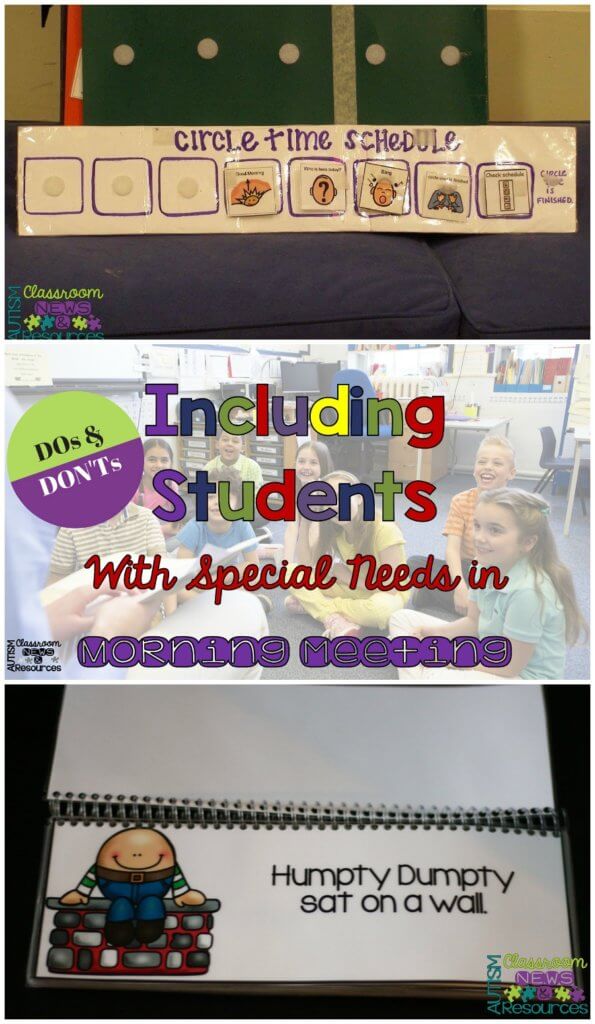Sharing is caring!
 I’ve talked here before about morning meeting and increasing engagement for students with disabilities. Today I wanted to talk a bit about how we can include students with significant disabilities in morning meeting in the general education classroom. Most younger grades have a calendar, morning meeting, chit chat or circle time as part of their daily routine. Obviously, there is a big difference between participating in a small group of 8-10 students at a slower pace in a special education setting and participating in a general education kindergarten class with 20-30 students at a much faster pace. Regardless of the size, though, I love morning meeting as an opportunity, particularly for the younger grades, to include students with disabilities in the general education settings because they include so many social opportunities. This is a time of day, in our increasingly academic-focused classrooms, when the students work on turn taking, conversation, listening in a group, learning in a group and more. This is a great time to work on those skills with our students with disabilities as well, but we need to provide some accommodations to help them be successful. We want this to be a great experience for the whole classroom so that everyone is getting what they need. So today I’m going to share some Dos and Don’ts I’ve found for helping students with disabilities, particularly communication disabilities and behavioral concerns, in the general education classroom morning meeting.
I’ve talked here before about morning meeting and increasing engagement for students with disabilities. Today I wanted to talk a bit about how we can include students with significant disabilities in morning meeting in the general education classroom. Most younger grades have a calendar, morning meeting, chit chat or circle time as part of their daily routine. Obviously, there is a big difference between participating in a small group of 8-10 students at a slower pace in a special education setting and participating in a general education kindergarten class with 20-30 students at a much faster pace. Regardless of the size, though, I love morning meeting as an opportunity, particularly for the younger grades, to include students with disabilities in the general education settings because they include so many social opportunities. This is a time of day, in our increasingly academic-focused classrooms, when the students work on turn taking, conversation, listening in a group, learning in a group and more. This is a great time to work on those skills with our students with disabilities as well, but we need to provide some accommodations to help them be successful. We want this to be a great experience for the whole classroom so that everyone is getting what they need. So today I’m going to share some Dos and Don’ts I’ve found for helping students with disabilities, particularly communication disabilities and behavioral concerns, in the general education classroom morning meeting.
1. Do use a consistent routine.
A consistent routine doesn’t mean it’s the same activities everyday, just that the morning meeting happens at about the same time most days and that there is a general order to the type of activities (e.g., pledge of allegiance, hello song, word of the day). You can change up the content but still have a regular routine, which benefits all the students to know the expectations.
2. Do use visuals
It really is helpful to many students to have an understanding of the order of activities. It helps them know how much more time there will be in an activity, when a favorite (or not favorite) activity is coming up, and helps them understand what the activities are about. Using a mini-schedule that the student can hold, or someone can show to the student as the routine progresses. For some students it can be a written list of activities, for others it might be a picture schedule.
3. Do use response cards or other interactive strategies
Many of our students are still learning how to wait their turn and have difficulty while waiting for 25 other students to be called on. Response cards are a system that all the students can have to answer questions and participate simultaneously. This is in contrast to the typical call-response or raising their hands and waiting to be called on. You don’t have to use it for every activity, but you can have students hold up a card or use a hand signal to answer. This way everyone has a turn and the opportunity to practice the skill for each question and there is limited waiting for a turn.

4. Do provide an extra copy of materials or pieces to interact with
Consider giving a student who is struggling a copy of the materials you are using (e.g., his own paper calendar, a smaller copy of the book). You could also give visuals to match pictures of the book or For students who struggle with sustained attention or knowing who and what to focus on, this helps them to stay in the game.
5. Do target communication and participation goals
Focus on specifically what skills are going to be targeted during morning meeting for this individual student. Then find one or two regularly occurring activities in which he can use a speech generating device or practice verbal exchanges, like greetings or commenting, each day. Try to choose something that you can repeat multiple times to get practice and make sure everyone on the team knows how to do it.
1. Don’t always sit the child with a disability in the back of the group
I know that sometimes it seems best to have the student sit where an adult can sit near him. However it can be harder for him to be part of the group if he is always at the outside edge. Think about having him be in the middle or at the front so he is truly included. A peer might serve as a prompter at times if needed.
2. Don’t assume a student can’t participate
It’s easy to assume that if a student has difficulty with sitting or behavioral concerns that he cannot participate at all. He can try participating for shorter periods of time. I would rather have a student participate successfully for a shorter period of time than try to keep him there for a longer period of time and have him fall apart. Also, consider having him join to participate for the time at the end of the activity so that he is there when the whole class transitions. That way he doesn’t leave in the middle of it. Then you can increase the time by joining earlier.
3. Don’t let one bad day eliminate the all participation
Instead, take it as an opportunity to problem solve as a team how to help next time and prevent it from occurring. Can you shorten time, change the part of the activity he joins, use more reinforcement for participating, change his or her seat, train a peer buddy…there are lots of strategies that the team can try to help him or her be successful if we work together as a team.
There are many more ways to support students within group activities, but hopefully this might spark some ideas to help you with your students. What strategies have you found that work well for helping students participate in morning meeting and other group times?
Until next time,
Looking for resources for morning meeting, check out my morning meeting kits in my store! A Christmas version is coming soon!
Looking for ideas for morning meeting? Check out my Pinterest board on everything morning meeting.









